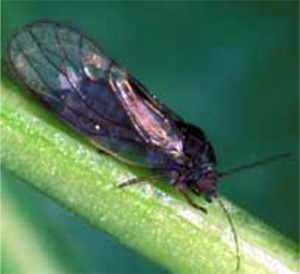Many materials available for pear psylla management
With high temperatures expected this week, Michigan pear producers should start managing for psylla by applying a dormant oil application with or without insecticide.
|
Michigan pear producers know that management of pear psylla presents a challenge each season. Psylla become active early and numbers can quickly grow to unacceptable levels. Also, the ability of this pest to rapidly develop insecticide resistance makes it especially important to carefully consider each material included in a management plan. A dormant oil application is a good start to a program that alternates materials with different modes of action (MOA) as needed throughout the remainder of the season. Given the temperatures expected this week, it would be a good time to start managing for psylla by applying a dormant oil application with or without insecticide.
Table 1 contains a list of products that are labeled for psylla control in Michigan pear orchards. Listed for each table entry are the MOA group number as assigned by the Insecticide Resistance Action Committee, common name, trade name and insecticide class.
Materials that share the same MOA group number have the same mode of action even if the number is followed by a different letter. For example, carbaryl has an MOA classification of 1A and diazinon of 1B. The number 1 indicates that both materials share the same MOA, in this case they are both cholinesterase inhibitors. The letter after the number represents the chemical sub-group. Notice that the last six table entries have no MOA classification and can be applied whenever appropriate for that material.
A sound resistance management program relies on treating successive generations of psylla with materials from different MOA groups. Read the label directions for complete information regarding application rates, timing, combination with adjuvants and precautionary statements regarding effects on natural enemies and bees. Do not underestimate the power of natural enemies in the management of pear psylla. An orchard of Bartlett pears at the Trevor Nichols Research Center in Fennville, Mich., unmanaged for psylla, has had no sign of psylla for the last several years.
Check the current “Michigan Fruit Management Guide” (E-154) for information on the effectiveness of many of the control options listed in the table.
Table 1. Insecticides labeled for pear psylla control in Michigan
|
MOA Group1 |
Common name |
Trade name |
Insecticide class |
|
1A |
carbaryl |
Sevin |
carbamate |
|
1B |
azinphosmethyl |
Azinphos-methyl, |
organophosphate |
|
1B |
chlorpyrifos |
Chlorpyrifos, Govern, Lorsban, Nufos, Warhawk, Whirlwind, Yuma |
organophosphate |
|
1B |
diazinon |
Diazinon |
organophosphate |
|
1B |
dimethoate |
Dimate |
organophosphate |
|
1B |
methidathion |
Supracide |
organophosphate |
|
2A |
endosulfan |
Endosulfan, Thionex |
organochloride |
|
3 |
deltamethrin |
Battalion, Delta Gold, Decis |
pyrethroid |
|
3 |
esfenvalerate |
Asana XL, Adjourn |
pyrethroid |
|
3 |
fenpropathrin |
Danitol |
pyrethroid |
|
3 |
gamma-cyhalothrin |
Proaxis |
pyrethroid |
|
3 |
lambda-cyhalothrin |
Silencer, Warrior |
pyrethroid |
|
3 |
permethrin |
Ambush, Arctic, Pounce, Perm-Up, Permethrin |
pyrethroid |
|
3 |
zeta-cypermethrin |
Mustang Max |
pyrethroid |
|
3 |
pyrethrins |
Pyganic |
pyrethrin |
|
3, 27A |
pyrethrin + piperonyl butoxide |
Evergreen |
pyrethrin |
|
4A |
acetamiprid |
Assail |
neonicotinoid |
|
4A |
clothianidin |
Clutch |
neonicotinoid |
|
4A |
imidacloprid |
Couraze, Pasada, Provado, Impulse, Nuprid, Prey |
neonicotinoid |
|
4A |
thiacloprid |
Calypso |
neonicotinoid |
|
4A |
thiamethoxam |
Actara |
neonicitinoid |
|
5 |
spinetoram |
Delegate |
spinosyn |
|
6 |
abamectin |
Abacus, Abba, Agri-Mek, Epi-Mek, Reaper, Zoro |
antibiotic |
|
6 |
emamectin benzoate |
Proclaim |
avermectin |
|
7C |
pyriproxifen |
Esteem |
insect growth regulator |
|
15 |
diflubenzuron |
Dimilin |
benzoylurea |
|
16 |
buprofezin |
Centaur |
insect growth regulator |
|
18B |
azadirachtin |
Aza-Direct, Ecozin, Neemix |
botanical |
|
21 |
fenpyroximate |
FujiMite, Portal |
phenoxypyrazole |
|
21 |
pyridaben |
Nexter |
pyridazinone |
|
sulfur |
Golden-Dew, Kumulus DF, Micro Sulf, Microthiol Disperss, Sulfur-DF |
||
|
horticultural oil |
horticultural oil |
||
|
calcium polysulfides |
Rex Lime Sulfur Solution, Sulforix |
||
|
kaolin clay |
Surround |
particle film |
|
|
oil, paraffinic |
Citrus oil, JMS Stylet-oil |
||
|
potassium salts of fatty acids |
M-Pede |



 Print
Print Email
Email



